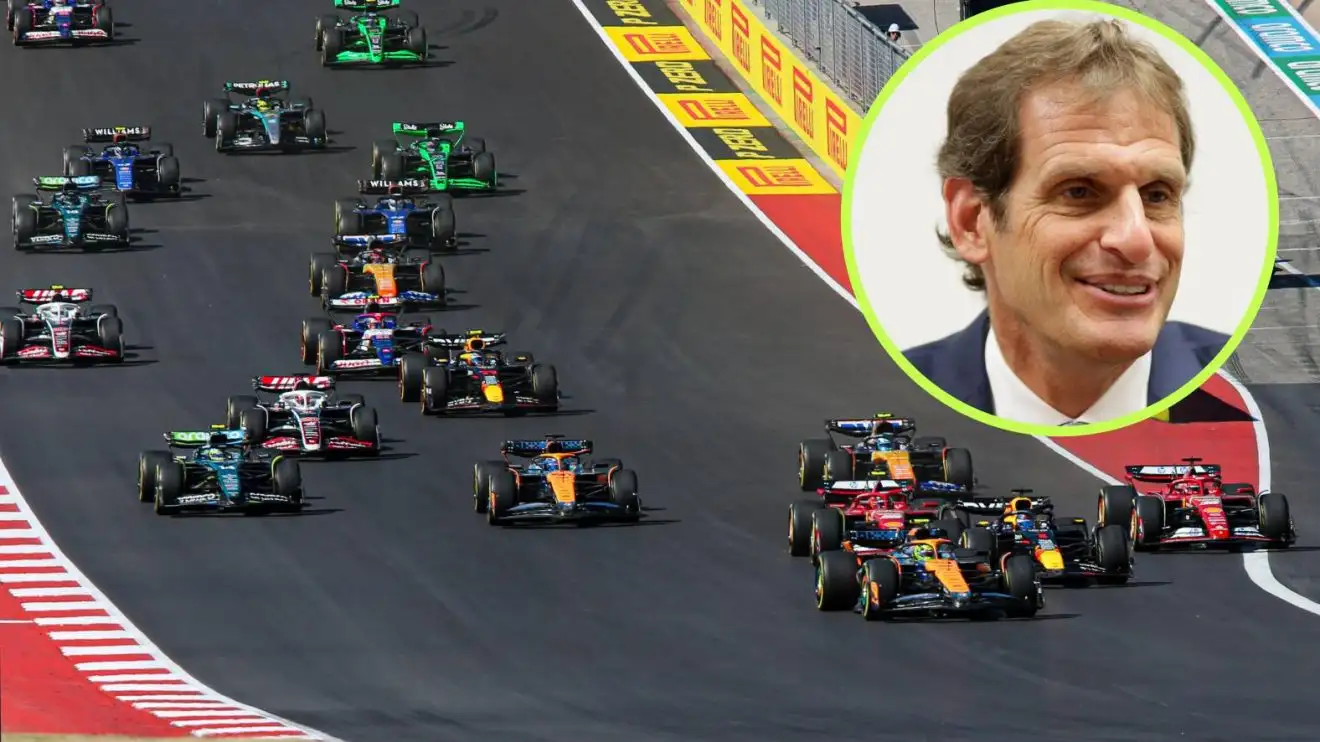COTA boss: F1 Sprint races don’t drive extra ticket sales but add entertainment

Bobby Epstein believes F1 Sprint races count for ticket value, but don't help drive ticket demand in the first place.
Circuit of the Americas’ (COTA) boss Bobby Epstein says Formula 1’s Sprint race format gives fans more for their money, but he doesn’t believe the format is a major driver of ticket sales.
While F1 CEO Stefano Domenicali has hinted that more Sprint weekends could appear on future F1 calendars, Epstein remains unconvinced that the format makes a significant difference to fans deciding whether to attend a Grand Prix.
Bobby Epstein: F1 Sprint races deliver more value to a ticket
This year’s calendar includes six Sprint events, with Austin this weekend among them. Since debuting in 2021 with three trial runs, the format has expanded to six weekends per season. That number is set to stay for 2026, though an increase for 2027 hasn’t been ruled out.
COTA first hosted a Sprint race in 2023 and will stage its third next month. Epstein says the format enhances the experience for those who attend, even if it doesn’t boost sales.
“I think it just gives more value to the ticket, and for that, we appreciate it,” he told select media, including PlanetF1.com.
“I don’t know that it’s translated to a lot more in ticket sales, but the fans seem to be warming up to it.
“It wasn’t immediately seen as a desirable asset, and it didn’t necessarily drive ticket sales for a while. I just think it increases the value of the ticket and gives people more, which we always appreciate.
“It does provide value to the fan that does buy a ticket; it gives them more for their money, and so, for that reason alone, we want as much entertainment as we can get for the weekend.
“So I’m for it just because… we do a lot of things that don’t necessarily sell more tickets, but they make the experience great for the fan that comes. I think this would be one of those items.”
Epstein admitted his stance hasn’t shifted much since COTA’s first Sprint weekend two years ago.
“I’m still not sure that it drives ticket sales, but if it does bring people out, if they’re buying a weekend pass and they stay more hours at the circuit, that’s better for us… [it’s] more content,” he said.
“I don’t know that people make their buying decision about whether they decide to come to a Grand Prix because it has a Sprint race or not. I still don’t know that that’s a key driver, but maybe it becomes one, and maybe it’s becoming more so.
“I have to look at the data and see if our Saturday ticket sales versus Sunday or Friday have changed in terms of the attendance and scan rates.
“We just haven’t seen it move the needle in terms of sales and demand, but I have no doubt that it’s more entertainment, and we’re all about that.”
What does Austin’s F1 future look like?
Since joining the calendar in 2012, COTA has been central to Formula 1’s surge in popularity in the US, paving the way for races in Miami and Las Vegas. The Austin round remains a fan favourite, but its contract with F1 runs only until 2026.
Epstein is hopeful about a renewal.
“Conversations are ongoing, and I think we’re optimistic,” he said. “I have little doubt that they [F1] want to do anything but continue, and likewise, [so] do we.
“So that is a pretty good starting point for conversation, but there hasn’t been a sense of urgency on either one of our ends, I don’t think. When it’s time, we’ll make it, we’ll come to an agreement.”
While Austin was the first race in the United States to join the calendar after the disappearance of Indianapolis five years prior, Epstein has since seen two more races in the United States join the calendar as Miami and Las Vegas were introduced in 2022 and ’23, respectively.
Has he noticed any negative impact on COTA’s ability to draw a crowd since the arrival of the new US races?
“I think we’ve become friendly rivals, and each has its own identity,” he said.
“Mexico had a bigger negative impact on us when it came on, versus these races that have not had a negative impact and, if anything, are creative, particularly Miami.
“I think Miami being in the spring is a chance for the sport to come back to the US. What’s been great about that is it’s coming over sort of twice a year and is really good for us.
“It’s sort of like we’re commercials for each other, and we’re spread far enough apart.
“The Vegas race could have been a stressor, I think, in some ways, but it’s proven to be that they appeal to different audiences. So not bad, and I think they each have proven themselves to be unique enough that they can be sustaining.”
As for how he feels the requests made by F1 in order to remain an in-demand venue, Epstein said he hasn’t felt the goalposts have changed much since first arriving on the calendar in 2012.
“I don’t think there are many big differences really for us,” he said.
“I think that they would like to see an expanded Paddock Club. Our Clubs are all sold out this year, it’s been incredible the demand for the hospitality, so I think what they would like to see is a bigger Paddock Club, and we’re looking at creating something incredibly special that I hope we unveil along with a contract extension.
“So it’d be a Paddock Club, unlike any that anyone has currently. So that’s what we’re looking at, and we’re talking about, we’re very excited about it, both of us.”
More analysis from PlanetF1.com:
👉 Has McLaren really been playing favourites in Norris v Piastri title fight?
👉 Does F1 have a girlfriend obsession? What Singapore GP coverage actually reveals
COTA’s quest to build beyond its F1 Grand Prix
COTA continues to expand beyond racing, investing heavily in facilities to turn the venue into a year-round destination rather than being completely reliant on its Grand Prix.
A new hotel and the upcoming COTALAND amusement park, featuring the “Circuit Breaker” rollercoaster, are key parts of that vision. Epstein says the coaster is “51/49” likely to be certified and ready in time for this year’s Grand Prix.
“The hotel is making its way through city council approval about a month ago for a state programme that it wants to participate in, and we’re excited to have them as a tenant on campus, because it just means 700,000 to a million more visitors a year coming to the campus,” he said.
“That’s great for the upcoming amusement park or water park or any other entertainment, but it’s especially great when we’re trying to get new fans engaged in the sport, because if they can come out and simply see the track… many people can’t even visualize what an F1 track looks like.
“So many Americans still think of the oval for NASCAR. But, when they come out and see it and see what these drivers are up against, it gets them interested, especially the kids.
“When they see the venue, and they learn about the event and can take a tour of it and maybe take a tour of an F1 garage and learn a little bit about the technology behind the sport, they can become engaged in it.”
The amusement park sits between Turns 19 and 20, designed to overlook the circuit.
“The amusement park is built between Turns 19 and 20, intentionally along the edge of the track, with its main restaurant having a deck that looks out at the track,” Epstein explained.
“So, even if you’re out there with your family for a casual, enjoyable amusement park weekend, you still may be intrigued by what you see going by you on the track… [and] the amusement park is going to have what we’re calling the world’s greatest ride, which should be the world’s greatest ride, which would be the ability to take a hot lap on the track.
“If you’re a thrill seeker and you seek roller coaster rides, we’ve certainly got to have some big roller coasters. But what could be greater than getting a ride on a three and a half mile Grand Prix track?
“We think there are many creative ways to get people excited about the sport when it’s not there. The hotel is one of those things.”
Epstein added that diversifying the venue helps make it more sustainable beyond race weekends.
“This extra stuff probably still works, because a lot of the extra stuff is to appeal to the non-F1 fan, right?” he said. “They’re not coming because there’s a Grand Prix there. They’re coming because Austin’s a nice destination, and we don’t have anything like that for families in town.
“We can use that as a platform to get more fans for the sport. So yeah, I think it works. I think it works with or without the Grand Prix, but even better… certainly the Hot Lap programme is something that will do better if the race is there. But I think Austin is a good destination, independently.”
Read Next: Zak Brown responds to ‘ludicrous’ Oscar Piastri claim amid Alex Palou legal case

